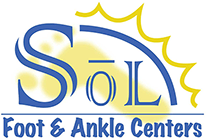 If you have a hard, bony prominence on the back of your heel bone, you likely have what's commonly called, a "pump bump" or Haglund's Deformity.
If you have a hard, bony prominence on the back of your heel bone, you likely have what's commonly called, a "pump bump" or Haglund's Deformity.
These prominences of the heel bone were given the name "pump bump" because they are more common in women who wear high-heeled "pump" style shoes. However, pump bumps commonly occur in both women and men, and not just in those who wear pumps.
Causes
Haglund's Deformity develops on the back of the heel because of chronic pressure from shoes. Your foot shape can also contribute to the development of the pump bump. If you continue to wear the wrong shoes, and pressure keeps being exerted on the bump, the heel bone will become inflamed, painful, and grow even larger.
Shoes are a major factor in making pump bumps get worse, but certain people are more likely to get them in the first place. Those with high arches and stiff ankles naturally get more rubbing of their shoes on the back of the heel. Also, people whose jobs require them to wear tight-fitting shoes, rigid shoes or high-heels are more likely to be bothered by pump bump pain.
Treatment
The number one key to alleviating the pain on the back of the heel is to get the shoe pressure off the area! This can be accomplished by wearing different shoes, open-backed shoes, shoes made of softer materials, lower heels, and shoes that are properly fitted.
It may be that your job doesn't allow you to wear a different style of shoe. For example, safety boots (another type of shoe that can exacerbate pump bump pain) may be a necessity at your job. Or, as is often the case, you may simply be unwilling to consider wearing shoes that are better for your feet.
If either of the above applies to you then the pain and size of your pump bump is likely to get worse and worse.
You need to see a podiatrist!
A savvy podiatrist will have or can fabricate, pads for your shoes to try to keep them from pushing on the bump and also to position your foot differently inside the shoe.
Besides getting the pressure off of the bump, it's also important to bring down the inflammation. Sometimes an oral anti-inflammatory, such as ibuprofen or naproxen, will do the job. For others, it may be necessary to perform a cortisone injection.
In some cases, conservative treatment may not alleviate pump bump pain. And padding the area definitely won’t make them disappear. If the problem is severe enough, your podiatrist may recommend surgery to remove the bump. This type of surgery is usually out-patient and can be performed in a hospital or surgery center.
The important thing is that if you want to avoid pump bump surgery then you should try very hard to wear the appropriate shoes. If the pump bump is already there and is causing you pain, then seek early treatment before the pain gets out of control and the bump gets too big.
Find help from an experienced foot specialist call 562-433-0478.
